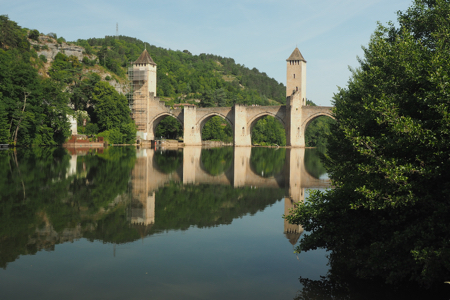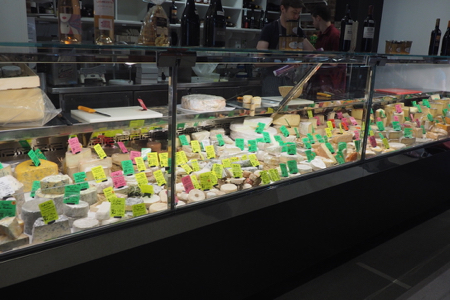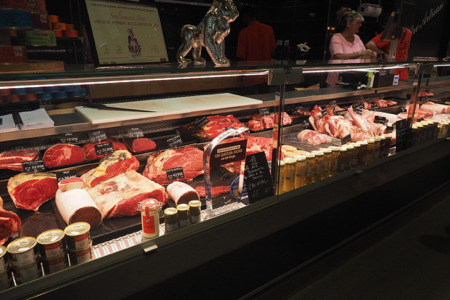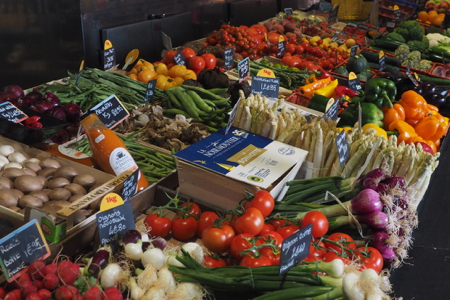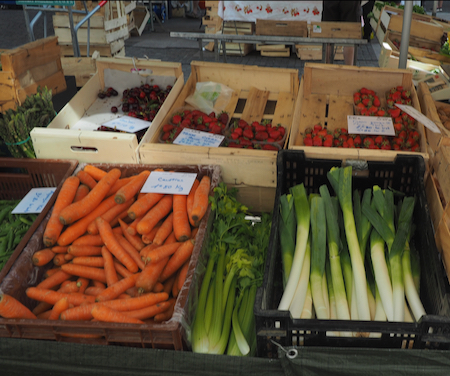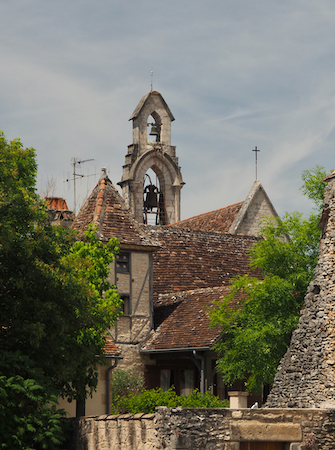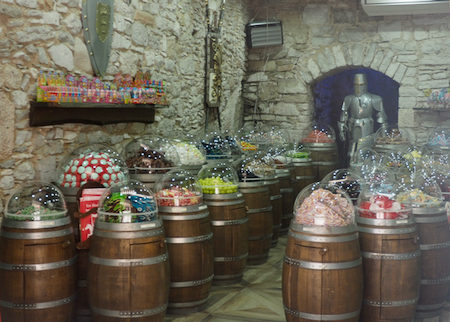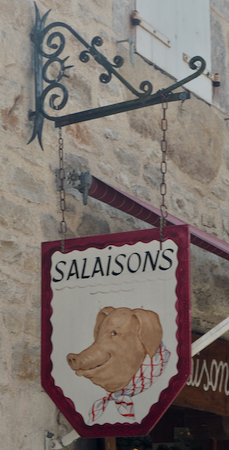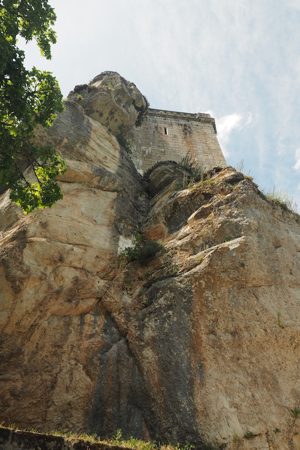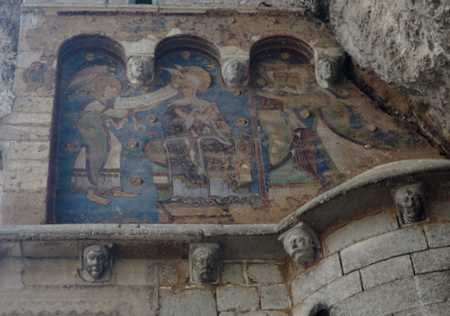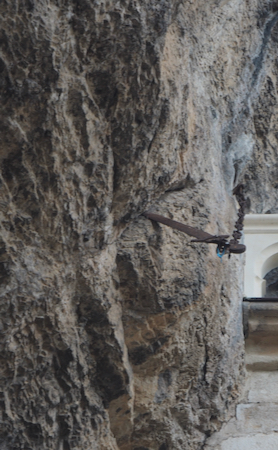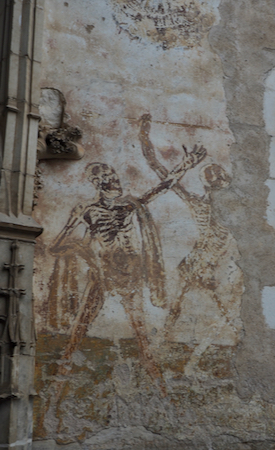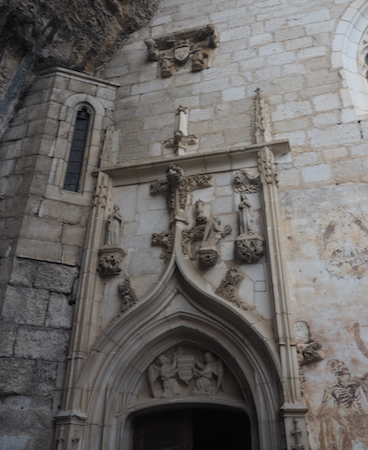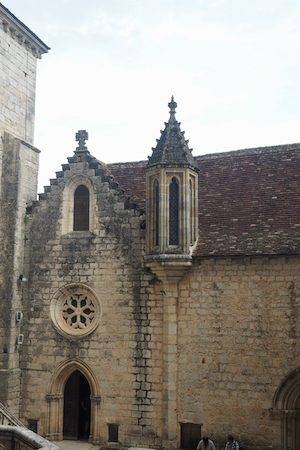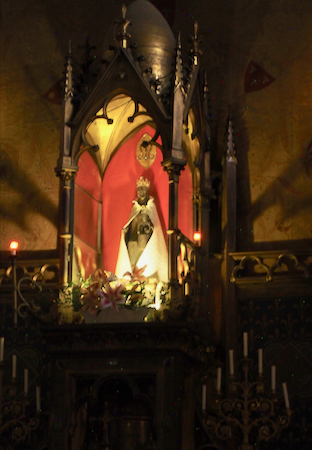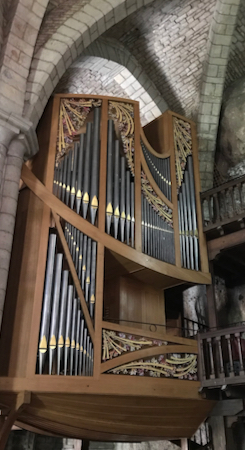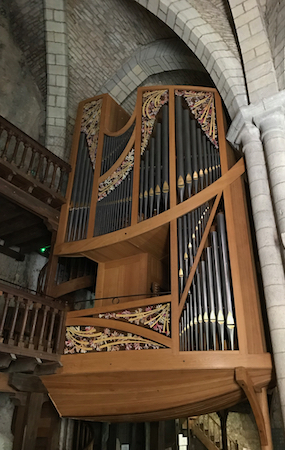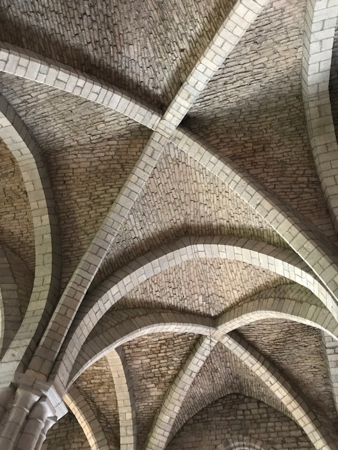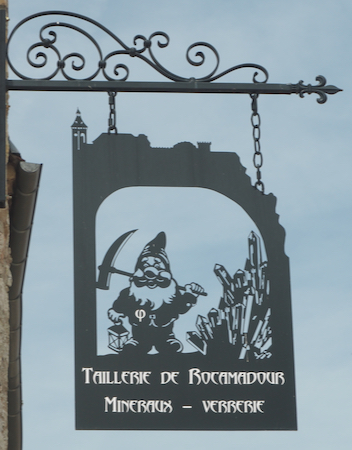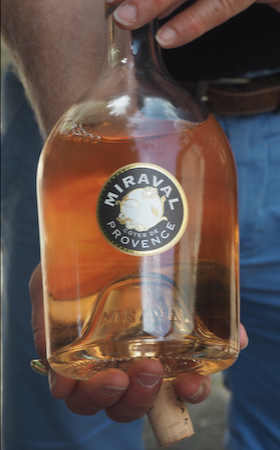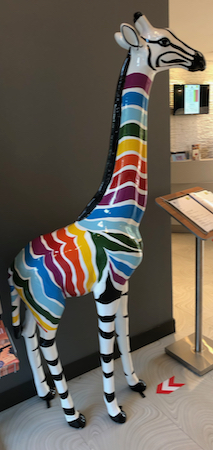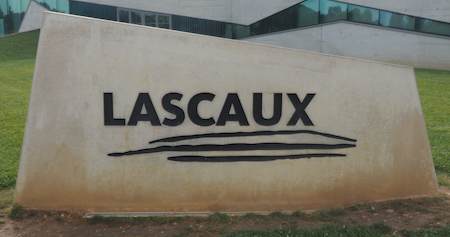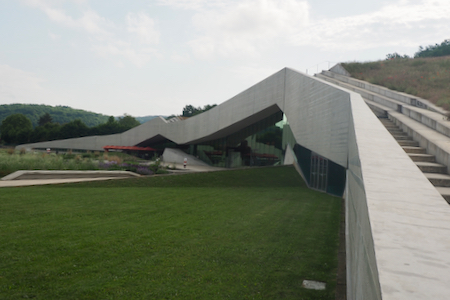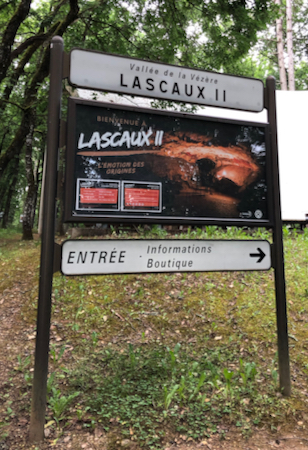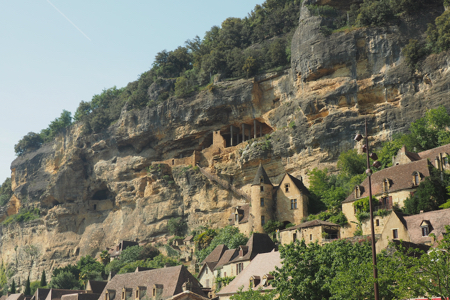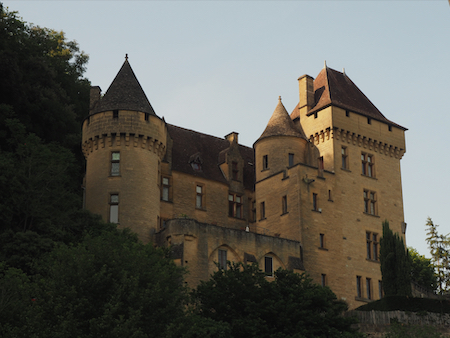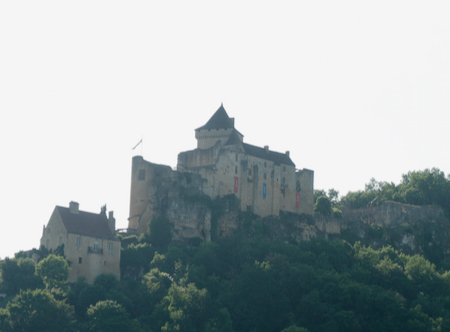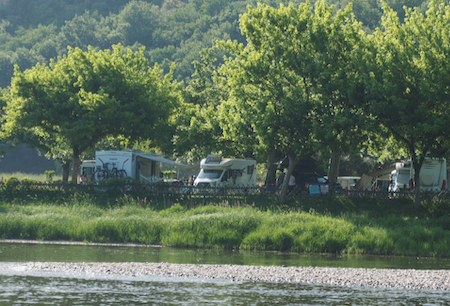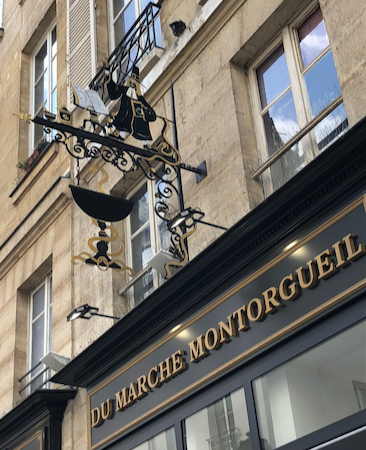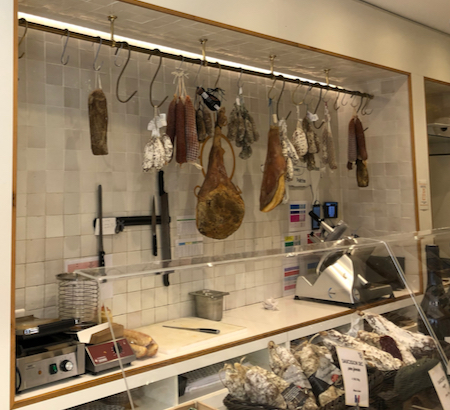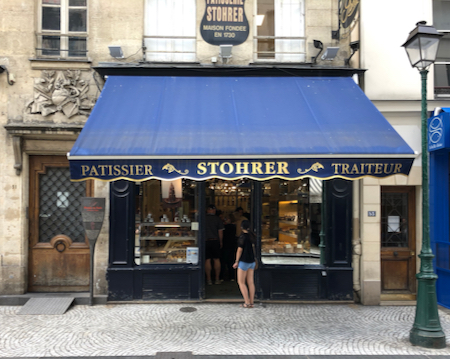Wed., 5/18/22 - Cahors, Rocamadour, and Sarlat
This morning's first stop was in the Roman city of Cahors. The Lot River runs through it and there is a “picturesque” bridge over the Lot - Pont Valentré. It has eight Roman arches and three watch towers. The bridge is called the Devil’s Bridge perhaps because it took 70 years to build in 1306. It was rebuilt only in 1880.
Cahors has the Lot River as well as several natural springs which made the area attractive to the Romans. Pope Clement V was born in Cahors. He is the Pope who moved the papacy to Avignon
Cahors also became a stop for pilgrims on the trail to Compostela in Spain. There are bronze seashells imbedded in the sidewalk marking the route.
We spent about two hours at the open and indoor markets. The indoor one was all food and rather upscale. I did purchase and apple tart (pomme tartelle) to finish our lunch. The outdoor market sold all kinds of things - clothes, food, plants, a long table on which everything was 1 euro.
Insight treated us to a tasting of Malbec black wine and it was served with canopies which we made into our lunch.
The public toilet at the market was another French experience. The cubical is all stainless steel and unisex. If the light is green, you can enter; it turns yellow when occupied. It locks when you close the door; you push a red button on the wall and push on the door to get out; if the yellow light is flashing, the cubical is being cleaned with jets of sterilizing water. We will be seeing more of these on streets in Paris which is where I saw my first one in 2001.
We drove though woodland areas with mostly duck farms for making foie gras. The ducks are force fed corn through a tube down their throats. Fat ducks have large livers, which equals more foie gras. There are also truffles in these woods, hence markets here are selling truffle things as well as foie gras.
Pont Valentré
A market - compleat with wine stalls - very French
Cheeses
Charles de Gaulle famously said: "How can anyone govern a nation that has two hundred and forty-six different kinds of cheese?"
Butcher's stall
Macarons
At least there are fresh vegetables in the markets even if they never seem to get to a restaurant meal.
Avocados and Artichokes
Garlic
Bread
Symbol for the Camino de Santiago - the Way of St. James
These symbols are found throughout France and Spain.
After Cahors, the highlight of the day was the visit to Rocamadour, a hill town with a 13th c. church and castle and houses perched on the side of a rock cliff.
Supposedly, a hermit named Amadour lived in a cliff cave and died in the cave. When his body was found in 1166 it was perfectly preserved. This was a “miracle” so a church was built and the place became another pilgrimage site.
Rocamadour
Bell tower
Candy store
Street scene
Cute sign
An elevator, tunneled into the cliff, took us up about 50 meters instead of climbing the 226 steps that pilgrims would climb on their knees to be absolved of their sins by the Black Madonna at the top.
The Black Madonna is in the Chapelle Notre-Dame. The wood carving is black from aged walnut wood, from pilgrims touching her, or from pollution - no one knows. The church is dedicated to Saint-Sauveur (Holy Savior) who is the patron of French sailors. Supposedly whenever a French ship is in danger from a storm or is lost at sea, the bell in the chapel rings, the sailors hear it, and sail toward the sound to find safety. Supposedly Jacques Cartier heard he bell ring in 1536 and found the mouth of the St. Lawrence River and “discovered” Canada.
There is also a myth about a Frankish knight, Roland, finding religion and throwing away his sword, Durandal, which landed in the cliff face just above the church entry. There are many myths about this “sword in the stone.”
Looking up at the Benedictine abbey of Tulle at the top
Churches built into the cliffs
Frescos on the wall of the Chapel of St. Michael
Fragment of Durandal, the sword of Roland, stuck in the wall
Wall mural
Entrance to the Shrine of the Black Madonna
Black Madonna
Church organ - left side
Church organ - right side
Vaulted ceiling
Steps we avoided
Nice sign
A treat
Thurs., 5/19/22 - Sarlat and Lascaux
The Insight tour spent two nights (one full day) in Sarlat and the OAT tour three night. Photos and descriptions of the town of Sarlat will be presented in the OAT section.
This morning’s visit was to the Lascaux Cave site. Lascaux is famous for its Paleolithic cave paintings and this visit was a primary reason for choosing the Insight tour.
In 1940, during WWII, four boys and a dog, Robot, found this incredible prehistoric cave. The dog was following a rabbit and went into a hole under the roots of a downed tree. The boys followed the dog and soon the whole village knew about a cave with prehistoric paintings and etchings on the walls and ceiling made 19,000 to 21,000 years ago by Cro-Magnon man. They were probably reindeer hunters at the end of an Ice Age with glaciers and ice to the north and livable conditions in this area.
Once the cave was open to visitors, deterioration began. In the 1950s the paintings suffered from “green” disease with moss and lichen forming on the walls. DDT killed that but by the 1960s it was “white” disease from the CO2 from visitors’ breath. To protect this wondrous piece of history, in 1983 an exact replica of the original cave was built further down the hill. This is called Lascaux II (L2). It took two years to build L2 and the new tunnel cave exactly matches the original. It then took nine more years to reproduce exactly the wall surfaces and paintings. L2 shows 65% of the original work and L4, the new museum which opened in 2016, shows 95% but it is a modern museum with children’s activities and digital displays. We were lucky enough to visit L2. Over all the L1 cave (the original - real - cave) has something like 6,000 paintings and 14,000 etchings. They have also found 120 grease lamps the Cro-Magnon men must have used. Only a few researchers are allowed in L1 now and they wear complete contamination suits. This is a must see! It was the highlight of the entire six weeks!A second link, showing many illustrations of the cave art. No photos were permitted inside the cave so this presentation isn't particularly stunning, but the cave itself surely is.
Darling giraffe statue at the hotel in Sarlat
Lascaux IV
Sign for Lascaux II
After lunch and a brief rest, the group departed for an optional boat ride on the Dordogne River and dinner.
The Dordogne River was another trade route river taking wine to the coast and bringing salt back. The current is swift - 14 kph. The town is built at the base of a cliff and people lived in “houses” in the cliff until 1947. The town is always at risk of rocks falling down on the houses.
The boat ride included an hour of narration about the history of the area. Wildlife sightings included nests of heron chicks high up in the trees on the banks, adult herons fishing along the banks, and a black kite perched in a tree looking for a nest to invade. The river is one of the cleanest in France and is controlled/regulated to stay that way. There is evidence (fossils) that in past eons the cliff was part of a coral reef.
Dordogne River boat
Cliff-side dwellings in the 9th c. town of La Roque-Gageac
One of the several castles along the river
Great blue heron
Another hilltop castle
Campground beside the river
Fri., 5/20/22 - Sarlat to Paris
Today was the long ride north to Paris. It is about 550 km or 340 miles from Sarlat. The drive along the A10 went past Limoges (known for its China) and Chateaux where airplanes are being stored until normal air travel resumes. This area is the "bread basket" of France and the fields are large and very healthy looking. There are wind turbines in the fields. France has no natural resources of oil, gas, or coal and would like to stop importing fuel (especially from Russia). We passed through a woodland area which is still a hunting reserve for wealthy men. Our drive took us around Orleans and over the Loire River - the Guardian River - and on into Paris and over the Seine River. Traffic only got bad once we were on the Paris ring road.
Sat., 5/21/22 - Paris
The morning was free for a leisurely breakfast and a trip across the street to the Congress shopping center to find an ATM.
At 1:30 there was a bus tour past the big Paris sights: the Arc de Triumph, down the Champs de Elysees, past the obelisk, the Musee d’Orsay, and the Louvre and on to the Du Marche Montorgueil, an authentic Parisian street market area for a Parisian food experience. Insight calls this a "Foodie Tour." Our guide took us to taste French hams (three kinds of sausage), bread (a date bread), four of the 256 French cheeses, and then French macarons. Our guide explained the French customs for eating these typical foods. It was a real treat.
The ham stop
A Paris street sweeper
Famous Stohrer Patisserie - the city's oldest bakery, founded in 1730
Our "farewell dinner" was at a fancy restaurant in Paris. The meal was good. For a starter we had either a poached egg on a slice of eggplant or cold green pea soup which had no seasoning. The main was either a slice of beef on a spoonful of mashed potatoes with four slices of carrot or Thai noodles which no one tried. Dessert was either pureed fruit (pink) or a puff pastry with ice cream and caramel or chocolate sauce poured over it. We finished with espresso coffee.
| Return to Top | Return to Itinerary | Return to Trips page to view other trips | Return to Dreamcatcher Home Page |
